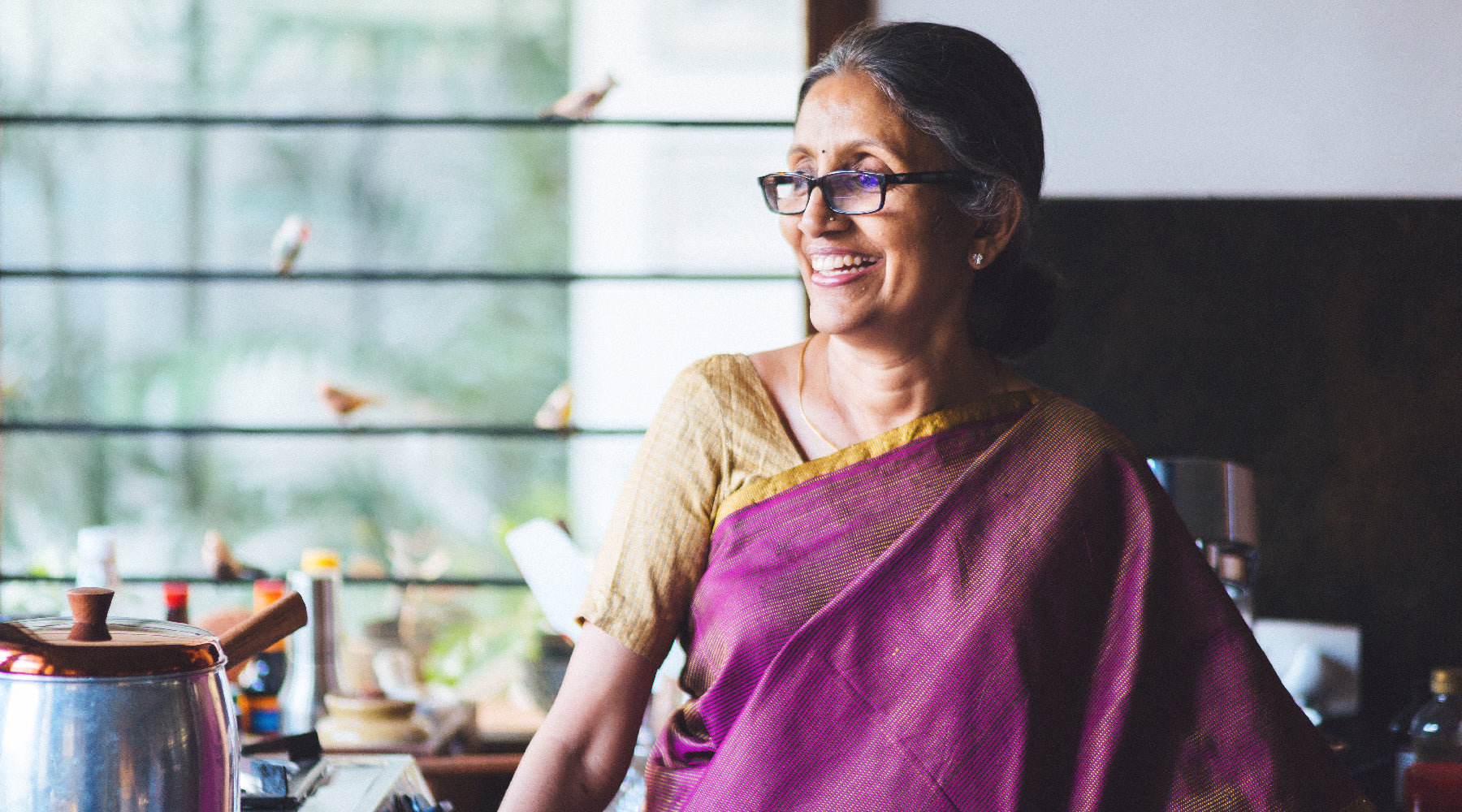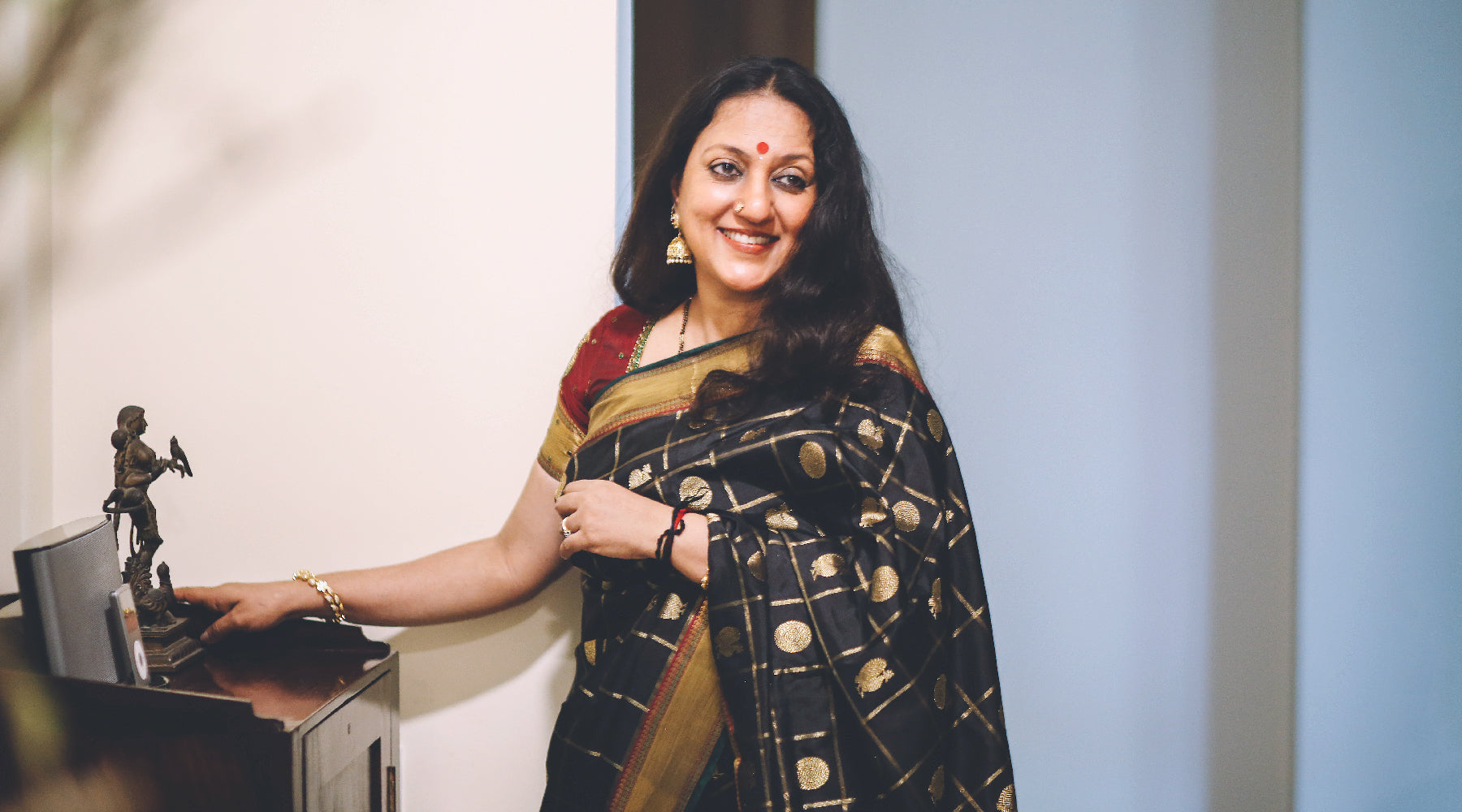KANAKAVALLI VIGNETTES : Thejo Menon - Artistic Expressions

An artist who has forged her own path, and a professor of art whose students bring her endless joy, Thejo Menon is truly a force to reckon with. Her childhood spent travelling Kerala with her parents is a constant source of inspiration to her, most notably in her bold use of pure colours on her canvases. Exploring themes of equality and spirituality in her exquisite figurative paintings, Thejo has never let anyone or anything dictate what kind of art she should be engaged in; working, instead, at her own pace, and delving into ideas that are important to her. In a conversation with Aneesha Bangera of the Kanakavalli Journal for February’s Vignettes, Thejo traces her journey as an artist, speaking with candour about the challenges and joys of the many roles she inhabits. Thejo also finds time in her busy schedule to curate a gorgeous selection of kanjivarams from the Kanakavalli repertoire; a curation that is testament to her eye for beauty and detail. Excerpts of the conversation below…..
Artistic Expressions
Early Encounters
My family is originally from Kerala, but I was born and brought up in Chennai. My parents both worked in the Malayalam film industry, though, so we would travel to Kerala very often. My father would always drive us, and I had the privilege of being driven all over the state. The vivid colours, the fragrances – everything I remember from those journeys – had a powerful impact on me. I was fascinated by the way art directors worked in those days. I spent a lot of time on set and in the studios, and observed the different ways in which they represented ideas for a film. At the time, every single scene was created in the studio – from vast, sloping landscapes, to a setting moon – and I was amazed at how they were brought to life. These are some of my earliest memories of appreciating art… I never thought I’d become an artist. In school, while I was encouraged to participate in the arts, my first love was literature – I enjoyed reading and writing, and planned to major in English. I did spend a lot of time doodling and drawing too, and decided to take the entrance test for both Literature and Fine Art at Stella Maris College. I was accepted into the Fine Arts course, and in a way, that’s where it all began.
From Art Student to Artist
After graduating, I went on to do my Masters in art, mostly because I didn’t have any other plans. I then got married and landed my first job as a professor in a college, teaching art and design in a department of Home Science. It was while teaching art that I began thinking about practicing it more seriously. I believed it would make me a better teacher, and also help me explore more facets of the field. While doing my thesis in Stella Maris, I had spent a lot of time in Cholamandal Artists’ Village, visiting the various studios, watching artists at work. And I continued to do this even after I began working. As I read and researched more about art, I grew more inspired. Mr. A V Ilango was my mum’s neighbour, and I worked under him for a long time. I also began to work independently, immersing myself in art. My interactions with various people in the field offered me new perspectives and helped me grow as an artist. Soon I began doing group shows, stepping out on my own. Making it on my own was quite a challenge. As an artist, there is a lot of pressure to identify oneself and one’s work with labels. And I have never been one to change myself or my art to suit the changing times. I have always done what I thought was good for me. I paint for myself, and not to make an impression on others. I try to challenge myself when I want to be challenged, I enjoy the process, I work at my own pace. And I feel fortunate to have the luxury of doing this, since I have a job as an art professor, and can afford to work on my art in my own way. I’m lucky to have a lot of very good friends in the art world, whose conversation and company are truly enriching.
On Colour, Form & Theme
One thing that has remained consistent through my work over the years is my approach to colour. I use only pure colours on the canvas. For example, I love this particular shade of green– it’s a clear, Kerala green that evokes memories of my childhood. Many people ask me why I don’t mix colours to produce varying shades, but I’ve always been strongly convinced that this was how I want to paint – using these bold, sure tones. I first experimented with all the vivid primary and secondary hues – red, blue, yellow, green, white – using them in their purest forms, and from there, my figurative style emerged. My firm belief in equality between women and men is a recurring theme across my canvases; a series that is ongoing. It represents the existence of the universe that began with the woman and the man, and I keep retelling this story in different ways. When I started out, I never identified the forms as male or female. But that changed overnight. Now, I like to sometimes make one of the forms a little more feminine. I also believe that there are so many qualities associated with men that women have too, and feminine qualities in men, so this has been an interesting exploration for me. And the two are always in a beautiful space – an environment filled with trees and greenery, much of which is inspired by my experience of Kerala as a child. I have also found a lot of comfort in religion, what some people now call spirituality. I was born into a Hindu family, grew up in a Christian convent and now teach in a Muslim college, and I am absolutely comfortable everywhere. For me, religion can never be a dividing force. I have worked on a series based on different faiths that I’m hoping to exhibit soon.

Questions of Originality
I teach 35 students in three batches, with theory and practical sessions, and I’m exhausted by the end of the week. But still, I take comfort in the familiar, continuing to paint and exhibit. There have been occasions when I’ve asked myself if I’m too stuck in my ways, if I’m known for only one way of painting. But then I realise I still have so much to say through my work, and that I am still exploring a certain aesthetic and certain themes. For a long time, selling was not the most important thing for me, even as my contemporaries began selling early and fast. I was more focused on creating my own language, and enjoying the creative process. I’ve realised that there will always be critics – people who question my sensibilities and my focus – but nothing phases me; I paint because I love to paint, and I feel fortunate to be able to do what I love. Another idea I have grappled with is that of originality. Of course, my work, especially my figurative forms, have been influenced to some extent by Ilango, with whom I worked for many years. But the themes and colours are my own, the lines are my own. I honestly don’t know how many things are truly original in the world anymore. Just by living in the world – viewing art, reading literature, watching films, travelling – we are constantly being influenced and inspired. So, I try not to worry so much about this idea of originality, and focus on being grateful for all the experiences and exposure I have had that make me the artist I am today.
The Joys of Teaching
I teach art and design to students of Interior Design in SIET, and am fortunate to have a group of extremely bright and talented young people in my class. My students come from families that have taught them important values and they are waiting to absorb everything that they can. It is a joy to teach them, and I’ve been doing it for 31 years now. I also help frame the syllabus, which includes visual art, graphic design, textiles, art appreciation, space planning, furniture design, and other varied elements of design that are interconnected and significant in this field. Finding Inspiration I’ve always been very fond of two of the greatest artists – Leonardo da Vinci and Vincent van Gogh. I love Van Gogh’s childlike approach and use of colour; the clarity with which he painted despite his many problems in life. Amongst the Indian artists, there are many who I consider great inspirations, especially M F Husain, for his incredible spontaneity. I also admire Anjolie Ela Menon. More than their success, it is their hard work that I look up to. I once met Anjali and asked her how she managed her work, with children and a family to care for. And she told me never to make excuses for myself because I’m a woman. She said that the challenge was to do everything and still be an artist, and this had a profound impact on me. I believe it is the little things that are often the biggest inspirations – if you can listen to people, keep your eyes and ears open, absorb everything that is meaningful to you, you will always be inspired.
On Beauty and the Sari
Beauty plays a very important role in my life. I am an optimist, and to me this means that I notice beauty. As an artist, I notice line, form, colour in everything around me. I like people with a sense of humour, I like people who are kind – these are types of beauty for me. When I was much younger I would only look at physical beauty, but over the years that has changed. Appearances of elegance or sophistication are no longer important. Beauty is not shallow, I’ve learnt; it is about having a good heart. I started wearing saris when I began working as a teacher. My mother-in-law was a great collector of kanjivarams, and built a wonderful collection over the years. I would often borrow her saris to wear, and they were all very beautiful. I did a course in textile design as part of my postgraduate course, and had the chance to visit Kanchipuram, interacting with the weavers and experiencing the kanjivaram sari first hand. I also teach a textile module now, and so textiles have always played an important role in my life. I love handlooms, I love cottons, and I feel lucky to live in a country that’s so rich in craft.

Thejo Menon is wearing a kanjivaram in royal blue, dotted with delicate floral buttis in gold zari. A broad gold tissue border with a green selvedge emphasises the palette of the drape. The pallu in mustard yellow features peacock motifs and geometric bands, all woven in gold zari.
The Kanakavalli Sari
My daughter is getting married in March, and we did all the wedding sari shopping at Kanakavalli. I believe that if you love traditional kanjivarams, then you don’t have to look beyond Kanakavalli. I love the traditional drapes, with large borders, the Ganga Jamuna formats… I love almost every single sari in Kanakavalli’s cupboards. The sari I’ve chosen to wear for the Vignettes feature is one I bought from the Adyar store some years ago. I love the rich, royal blue hue, the broad zari border and the stunning pallu. As soon as I saw it, I knew it was the perfect sari for me. It’s quite simple, but elegant and beautiful, and whenever I wear it, people really notice it.
- Thejo Menon, as recounted to Aneesha Bangera
Explore Thejo's Kanakavalli curation here



